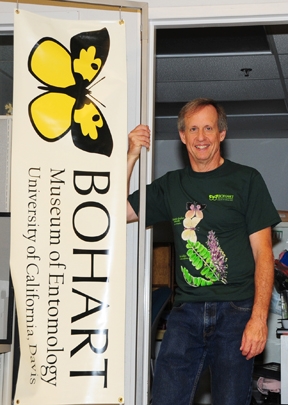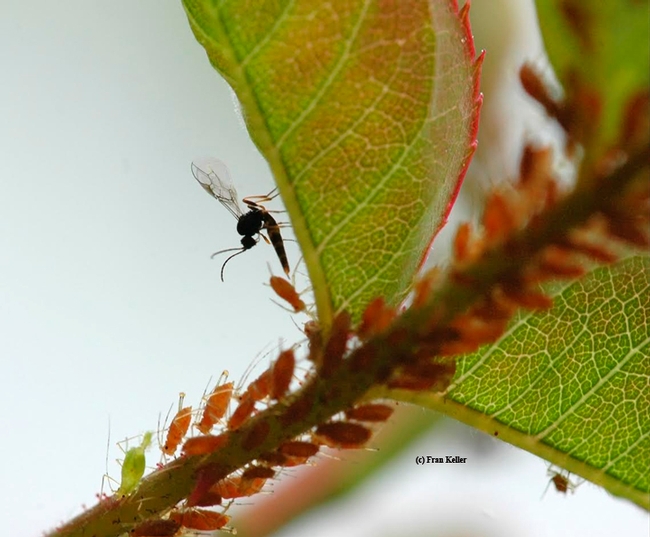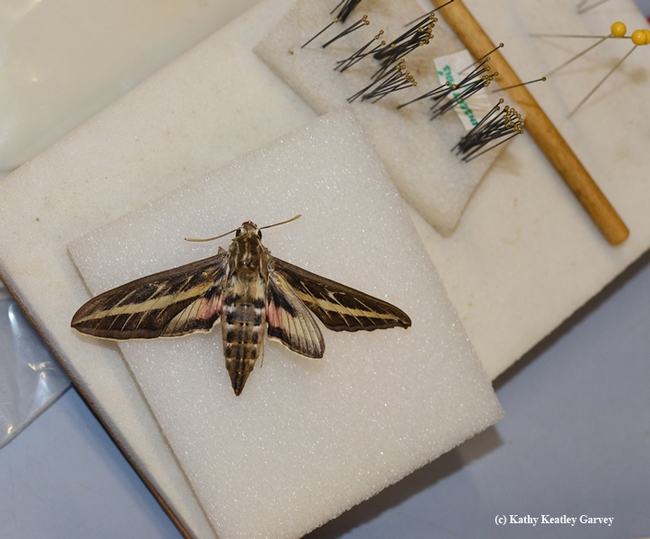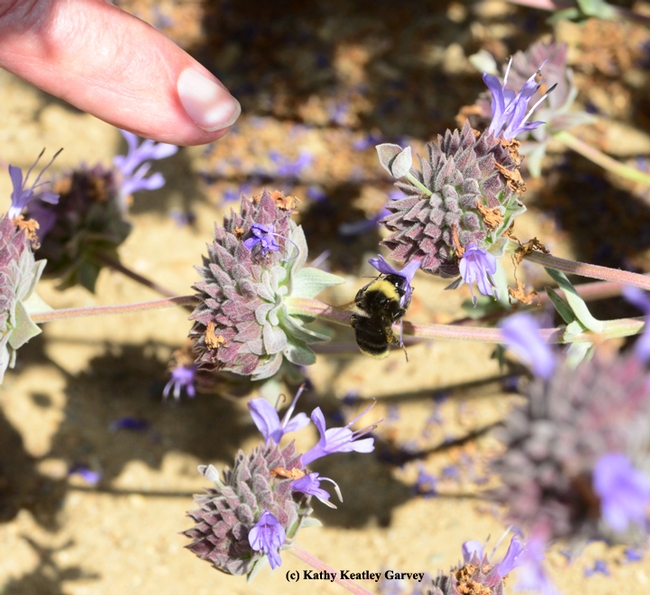- Author: Kathy Keatley Garvey

Say you're a caterpillar or an aphid and a wasp comes along and lays her eggs inside you. Her eggs will hatch and then her offspring will eat their way out. You, the host, are no more. Zero. Zip. Zilch.
If you visit the Bohart Museum of Entomology open house on Sunday, Jan. 11 on the University of California, Davis, campus, you'll learn all about parasitoids.
The fun, educational and family-friendly event is themed, "Parasitoid Palooza!" Free and open to the public, it takes place from 1 to 4 p.m. in Room 1124 of the Academic Surge Building on Crocker Lane,
"Most everyone knows that mantids eat other insects or that ladybird beetles (lady bugs) consume lots of aphids, but there is another way insects eat other insects," commented Tabatha Yang, education and outreach coordinator.
"An insect parasitoid is a species whose immatures live off of one insect host, usually eating it from the inside out," she said. "It is part of their life cycle and the host dies. This sounds like a weird way to make a living, but there are more species of parasitoids than there are insects with any other single kind of life history. The movie Alien with Sigourney Weaver co-opts this phenomenon, but in reality there are no parasitoids on humans or other vertebrates."
The Bohart open house will spotlight this unusual life cycle. Wasps, flies and beetles are parasitoids to many different insect groups.
Senior museum scientist and collections manager Steve Heydon, is a world authority on Pteromalids, or jewel wasps, a group of tiny parasitoids, and will be on hand to talk about them.

Live parasitoids from the lab of Michael Parrella, professor and chair of the UC Davis Department of Entomolology and Nematology will be showcased. They include Encarsa, Eretmocerus, Diglyphus and Aphidius.
"Parasitoid Palooza" promises to be a fun and wacky celebration of the diversity of life, Yang said. A family-friendly craft activity with balloons inside of balloons (representing parasitoids) is planned.
Before you go, be sure to check out Wired.Com's piece on a wasp from the genus Glyptapantele laying eggs in a caterpillar. Tachinid flies also provide biological control services, laying their eggs in a number of insects, including beetles, moths, sawflies, earwigs and grasshoppers.
Along with parasitoids, visitors will see some "teddy bear" bees or male Valley carpenter bees, to be shown by native pollinator specialist Robbin Thorp, emeritus professor of entomology at UC Davis. Allan Jones of Davis, a noted insect photographer, delivered some to Thorp's office in the Harry H. Laidlaw Jr. Honey Bee Research Facility last week. Their origin? A friend's felled apple tree in Davis. The tree had rotted and male and female Valley carpenter bees were wintering inside.
The Bohart Museum, directed by Lynn Kimsey, professor of entomology at UC Davis, houses a global collection of nearly eight million specimens. It is also the home of the seventh largest insect collection in North America, and the California Insect Survey, a storehouse of the insect biodiversity.
Special attractions include a “live” petting zoo, featuring Madagascar hissing cockroaches, walking sticks and tarantulas. Visitors are invited to hold the insects and photograph them. The museum's gift shop, open year around, includes T-shirts, sweatshirts, books, jewelry, posters, insect-collecting equipment and insect-themed candy.
The Bohart Museum's regular hours are from 9 a.m. to noon and 1 to 5 p.m. Mondays through Thursdays. The museum is closed to the public on Fridays and on major holidays. Admission is free. Open houses, focusing on specific themes, are held on weekends throughout the academic year.
The remaining schedule of open houses:
- Sunday, Feb. 8: “Biodiversity Museum Day,” noon to 4 p.m.
- Saturday, March 14: “Pollination Nation,” 1 to 4 p.m.
- Saturday, April 18: UC Davis Picnic Day, 10 a.m. to 3 p.m.
- Sunday, May 17: “Name That Bug! How About Bob?” 1 to 4 p.m.
- Saturday, July 18: “Moth Night,” 8 to 11 p.m.
More information is available by contacting Tabatha Yang, education and public outreach coordinator at tabyang@ucdavis.edu or (530) 752-0493.

- Author: Kathy Keatley Garvey

And you'll meet them and see their amazing work at the Bohart Museum of Entomology's open house from 1 to 4 p.m. Saturday, Dec. 20 in Room 1124 of the Academic Surge Building, Crocker Lane, UC Davis campus. The event, appropriately themed "Insects and Art," is free and open to the public.
Keller, who received her doctorate in entomology from UC Davis this year, and Kareofelas, a Bohart associate (volunteer) and naturalist (he specializes in butterflies and dragonflies), will staff a table at the museum. Together they've created insect posters (think dragonfiles and butterflies), insect-themed t-shirts and a children's book, "The Story of the Dogface Butterfly." The book, focusing on California's state insect, the California dogface butterfly, features text by Keller, photos by Kareofelas and Keller; and illustrations by UC Davis graduate Laine Bauer. The educational book is available in the Bohart Museum's gift shop.

Like Keller, Kareofelas is known for his enthusiasm and fascination with insects. His volunteer association with the Bohart Museum dates back 25 years; that's how long he has donated specimens to the museum and assisted with projects. He's collected moths and butterflies in California, Nevada and South America. He's reared numerous butterfly species, including California dogface, Gulf Fritillaries, monarchs and swallowtails. In rearing them, he's able to see and share the life cycle (egg, larva, chrysalis and adult). This skill enables him to tell what egg and what caterpillar will turn into what butterfly. That's an identification skill not many have.
Both Keller and Kareofelas enjoy photographing insects. (Check out Kareofelas' image of overwintering lady beetles (aka ladybugs).
The Bohart Museum open houses are always family-oriented. The family activity on Dec. 20 will be crafting small insect sculptures out of wire and beads, said Tabatha Yang, the Bohart's education and outreach coordinator.

- Diane Ullman, professor of entomology and co-founder and co-director of the UC Davis Art/Science Fusion Program. Ullman and colleague Donna Billick, co-founder of the program, taught Entomology 001 students how to fuse art with science. Their work is displayed around campus and beyond.
- Students from Art 11, a beginning printmaking class taught by lecturer Bryce Vinkorov of the UC Davis Department of Art and Art History. The class borrows educational drawers from the museum and then creates works of art inspired by the assortment of insects. Vinkorov says: ""My classes have used bugs from the Bohart as inspiration for their linocut prints for the past thee years. They are fascinated by the variety of color and body shapes of these bugs. The larger color prints are linocut reductions. I am very thankful that the Bohart lets this kind of cross-pollination happen."
- Kathy Keatley Garvey, communications specialist for the UC Davis Department of Entomology and Nematology and an avid insect photographer. One of her macro images of a flameskimmer dragonfly graces the Entomological Society of America's 2015 world insect calendar.
- Nicole Tam, an entomology undergraduate student and artist. Her work includes insect-themed drawings and paintings.
- The late Mary Foley Benson, a former Smithsonian Institution scientific illustrator who lived the last years of her life in Davis, and worked for faculty in the Department of Entomology (now the Department of Entomology and Nematology).
- Tom Roach of Lincoln, photographer, and Leo Huitt of Woodland, wood sculpture. Their work is on permanent display in the Bohart.
The museum, founded by noted entomologist Richard M. Bohart (1913-2007), houses a global collection of nearly eight million specimens, and is also the home of the seventh largest insect collection in North America, and the California Insect Survey, a storehouse of the insect biodiversity.
Special attractions include a “live” petting zoo, featuring Madagascar hissing cockroaches, walking sticks and tarantulas. Visitors are invited to hold the insects and photograph them. The museum's gift shop, open year around, is stocked with T-shirts, sweatshirts, books, jewelry, posters, insect-collecting equipment and insect-themed candy.
The museum holds open houses throughout the academic year. Its regular hours are from 9 a.m. to noon and 1 to 5 p.m. Mondays through Thursdays. The museum is closed to the public on Fridays and on major holidays. Admission is free.
The remaining schedule of open houses:
- Sunday, Jan. 11: “Parasitoid Palooza,” 1 to 4 p.m.
- Sunday, Feb. 8: “Biodiversity Museum Day,” noon to 4 p.m.
- Saturday, March 14: “Pollination Nation,” 1 to 4 p.m.
- Saturday, April 18: UC Davis Picnic Day, 10 a.m. to 3 p.m.
- Sunday, May 17: “Name That Bug! How About Bob?” 1 to 4 p.m.
- Saturday, July 18: “Moth Night,” 8 to 11 p.m.
More information is available by contacting (530) 752-0493 or Tabatha Yang, education and public outreach coordinator at tabyang@ucdavis.edu


- Author: Kathy Keatley Garvey

Worker bees are males, right?
Butterflies and moths can't fly if you rub the scales off their wings, right?
Earwigs crawl into your ears and then into your brain, right?
Wrong. They're all widely known but falsely held beliefs.
What better place to learn about insect myths than the UC Davis Bohart Museum of Entomology, home of nearly eight million insect specimens? An open house is scheduled from 1 to 4 p.m., Sunday, Nov. 23, in Room 1124 of the Academic Surge building, Crocker Lane.
The Bohart folks will dispel scores of myths, including these:
- Brown recluse spiders are found in California
- Daddy long-leg spiders are very venomous, but their mouths are too small to bite us.
- We swallow/eat a significant amount of spiders/insects in our sleep.
The open house is free and open to the public, and family friendly.
Directed by Lynn Kimsey, professor of entomology at UC Davis, the insect museum is also the home of the seventh largest insect collection in North America, and the California Insect Survey, a storehouse of the insect biodiversity.
Special attractions include a live "petting zoo," featuring Madagascar hissing cockroaches, walking sticks and tarantulas. Visitors are invited to hold the insects and photograph them. In addition, face painting will be among the family-oriented activities. Think bugs!
Visitors can also browse the gift shop, which includes T-shirts, sweatshirts, books, jewelry, posters, insect-collecting equipment and insect-themed candy. (Gifts can also be purchased online.)
The Bohart Museum's popular open houses are in addition to its regular weekday hours, from 9 a.m. to noon and 1 to 5 p.m. Mondays through Thursdays. It is closed to the public on Fridays and on major holidays. Admission is free.
Here's a list of open houses through Saturday, July 18:
- Saturday, Dec. 20: “Insects and Art,” 1 to 4 p.m.
- Sunday, Jan. 11: “Parasitoid Palooza,” 1 to 4 p.m.
- Sunday, Feb. 8: “Biodiversity Museum Day,” noon to 4 p.m.
- Saturday, March 14: “Pollination Nation,” 1 to 4 p.m.
- Saturday, April 18: UC Davis Picnic Day, 10 a.m. to 3 p.m.
- Sunday, May 17: “Name That Bug! How About Bob?” 1 to 4 p.m.
- Saturday, July 18: “Moth Night,” 8 to 11 p.m.
More information is available by contacting (530) 752-0493 or Tabatha Yang, education and public outreach coordinator at tabyang@ucdavis.edu


- Author: Kathy Keatley Garvey

Entomologist Jeff Smith, an associate at the Bohart Museum of Entomology, University of California, Davis, showed everyone from pre-schoolers to adults how to do just that at the Bohart's recent open house.
It was all hands-on.
Smith provided the dried insects and spreading boards. Each participant took home a pinned butterfly on a spreading board for later removal and display. Smith also contributed the labels.
Cassidy Hansen of Rio Vista, a 2012 graduate of Rio Vista High School, was among the participants. She said she may decide to major in entomology.
Smith asked a group of participants why the proboscis (tongue) of a white-lined sphinx moth (Hyles lineata), commonly known as the hummingbird moth, is so long. Some looked puzzled. "To reach the nectar of tubed flowers," he answered. Smith then pulled out the proboscis to show them the length.
The participants also admired the research collection, held exotic insects and arthropods, viewed a bee observation hive, and collected insects on the lawn behind the building.
This was the first in a series of open houses planned during the academic year.All open houses are free and open to the public.
The schedule:
- Sunday, Nov. 23: “Insect Myths,” 1 to 4 p.m.
- Saturday, Dec. 20: “Insects and Art,” 1 to 4 p.m.
- Sunday, Jan. 11: “Parasitoid Palooza,” 1 to 4 p.m.
- Sunday, Feb. 8: “Biodiversity Museum Day,” noon to 4 p.m.
- Saturday, March 14: “Pollination Nation,” 1 to 4 p.m.
- Saturday, April 18: UC Davis Picnic Day, 10 a.m. to 3 p.m.
- Sunday, May 17: “Name That Bug! How About Bob?” 1 to 4 p.m.
- Saturday, July 18: “Moth Night,” 8 to 11 p.m.
The Bohart Museum is located in Room 1124 of Academic Surge building on Crocker Lane, off LaRue Road. Directed by Lynn Kimsey, professor of entomology at the University of California, Davis, the Bohart Museum houses nearly eight million insect specimens, a live “petting zoo” and a gift shop.
More information on the open houses are available from Tabatha Yang, education and outreach coordinator, at (530) 752-0493 or tabyang@ucdavis.edu.
Want to learn how make an insect collection? An award-winning collection of short videos on "How to Make an Insect Collection" is posted on the UC Davis Department of Entomology and Nematology website and on YouTube. These student-produced videos, directed by Professor James Carey, are short and concise. The project won an award from the Entomological Society of America. It is considered the best of its kind on the web.





- Author: Kathy Keatley Garvey
Bumble bees and spiders don't mix, you say?
Well, they will at the Bohart Museum of Entomology's open house from 1 to 4 p.m., Saturday, July 26. The family-centered event, free and open to the public, takes place in Room 1124 of the Academic Surge building on Crocker Lane, UC Davis campus.
Actually the theme is about spiders: "Arachnids: Awesome or Awful?" There you'll see black widow spiders, jumping spiders, cellar spiders and the like. But you don't have to "like" them as you do posts on Facebook!
You can also learn about bumble bees. Native pollinator specialist Robbin Thorp, emeritus professor of entomology at UC Davis, will be one of the tour guides. Thorp co-authored the newly published Bumble Bees of North America: An Identification Guide, which is available in the Bohart gift shop. He can autograph your book and answer questions about how to attract bees to your garden.
Thorp was recently interviewed by Tom Oder of the Mother Nature Network on how to garden for bumble bees. So was Steve Buchmann, an adjunct professor in entomology and ecology at the University of Arizona.
Thorp told Mother Nature Network that some bumble bees are in very serious decline, and others are doing quite well.
So, how do you attract them to your garden? Buchmann was quoted as saying: “Gardening for bumblebees is similar to gardening for other bees and pollinators." To entice bumblebees to visit your garden, “plant mints, Salvia, Monarda, plants in the sunflower family and clovers."
Read Oder's article for more information.
And keep your eyes open for the soon-to-be-published California Bees and Blooms: A Guide for Gardeners and Naturalists, co-authored by entomologist Gordon Frankie of UC Berkeley, Thorp, and two others with UC Berkeley connections: photographer/entomologist Rollin Coville and floral curator Barbara Ertter.
As for Saturday, July 26 there won't be a vote on whether you like bumble bees or spiders better, nor will you be asked to sing "Itsy Bitsy Spider" or "Baby Bumble Bee." It promises, though, to be fun and educational. Plus, you can enjoy the live "petting zoo," featuring 24-year-old Rosie the tarantula, assorted walking sticks, and the colorful Madagascar hissing cockroaches. Yes, they hiss.
The gift shop is also popular. You can browse through the books, jewelry, t-shirts, sweatshirts, insect-themed candy, butterfly houses, and insect-collecting kits.
The Bohart Museum, directed by Lynn Kimsey, professor of entomology at UC Davis, houses nearly eight million insect specimens and is the seventh largest insect collection in North America. It is also the home of the California Insect Survey, a storehouse of insect biodiversity. Noted entomologist Richard M. Bohart (1913-2007) founded the museum.
The museum's regular hours are from 9 a.m. to noon and 1 to 5 p.m. Mondays through Thursdays. It's closed to the public on Fridays and on major holidays. Admission is free. For more information, email education and outreach coordinator Tabatha Yang at tabyang@ucdavis.edu or telephone her at (530) 752-0493.




